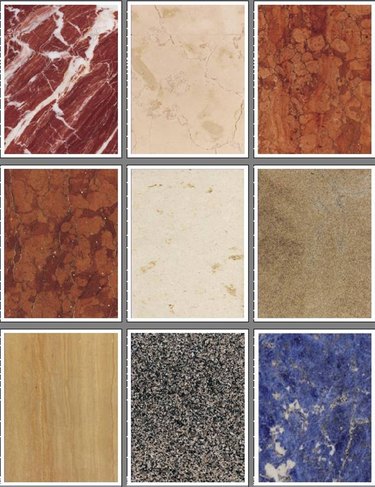Whether you are painting a scene for a theatrical set or just want to add some texture to a smaller project, marbling effects are fairly easy to create. Marbling makes use of at least three values of the same color to create the appearance of an uneven, mottled surface. It can be used to add warmth to a piece, on a garden wall supporting a climbing rose, or to create a forbidding atmosphere, used on the walls of a set for a prison scene. It all depends on the ratio of light to dark shading that you use.

Video of the Day
Things You'll Need
Large Piece Of Plain Cardboard
Gesso
Paint Tray
Paint Stick
Plastic Or Latex Gloves (Optional)
Black Acrylic Paint
Palette Knife
Artist'S Canvas
Drop Sheet
Chunk Of Natural Sponge
Acrylic Paint In The Color Of Your Choice
Palette
White Acrylic Paint
Water
Step 1
Smooth gesso onto your canvas with your fingers, following the directions in the video by Sandra Scheetz Wise, an acrylic artist in Orlando, Florida (see Additional Resources). Allow the gesso to dry. Smooth your canvas with a sanding block and coarse sandpaper. Spray the back of canvas with water as directed in the video. This provides a smooth surface and prepares your canvas for painting.
Video of the Day
Step 2
Look at as many marble samples as you can find. Note that marble comes in many colors and patterns in nature, which are determined by the various mineral impurities contained in a given sample.
Step 3
Decide on a base color. This is the color you will mix with black and white to create multiple values. Values are shades of a color from lightest to darkest.
Step 4
Start with an amount of paint that will cover the entire surface you intend to use--in this case, an artist's canvas. Pour or squirt out a nice sized blob of paint onto your palette. Scrape two-thirds of the blob away into another smaller blob with your palette knife. Add a blob of white paint equal to half the paint in the new, smaller blob. Mix well with your palette knife. Repeat this step, substituting black paint for white. Pull the two blobs of original color together and add more paint. You should have three approximately equal amounts of base color, lighter color and darker color.
Step 5
Dip a piece of dry, natural sponge in water and squeeze nearly dry, then dab it onto a piece of dry cardboard until you get only a very faint watermark. Dip the moistened sponge into your base color, then dab it against the cardboard several times. You want to get the paint to a point where it will just barely make a mark.
Step 6
Dab base color over the entire canvas, being careful not to use brush-like movements that would make smears of paint. You want to tap the sponge against the paper as if you are lightly powdering your nose.
Step 7
While your first coat of paint is still damp, take a new piece of sponge, moisten it like the first, and load it with the lighter color. Tap it gently all over the canvas, in whatever pattern pleases your eye. You may even want to take a paintbrush, dip it in water, then in your chosen color, and use a roll while dragging squiggle motion to make thin lines of color all over the canvas. These will resemble the veins you see in natural marble. Repeat this step with your darkest color.
Step 8
If you get too much of any one shade, go back with a lighter or darker shade and dab the sponges on the canvas again. Let it dry. From a distance, your faux marble will appear real.
Tip
Be sure to use natural sponge, not manufactured, or you will not get the right texture in your painting. Moisten sponge with water before use, and make sure to press it onto cardboard until nearly dry. Use light pressing and tapping motions rather than brushing motions, or your paint will smear. Experiment with various color combinations and patterns to see which ones you like best. Use your marbled canvasses as backgrounds for your next piece.